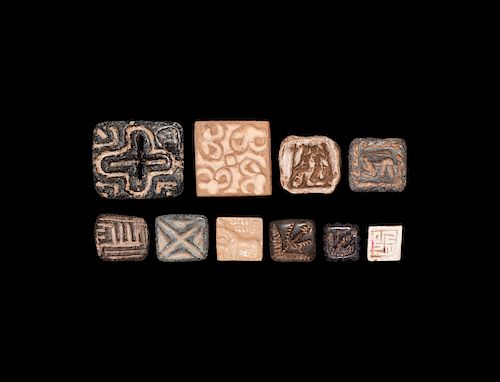Western Asiatic Stamp Seal Collection
Lot 423
About Seller
TimeLine Auctions Limited
The Court House, 363 Main Road
Harwick, Essex CO12 4DN
United Kingdom
Estimate:
GBP£800 - GBP£1,000
$1,081.08 - $1,351.35
Absentee vs Live bid
Two ways to bid:
- Leave a max absentee bid and the platform will bid on your behalf up to your maximum bid during the live auction.
- Bid live during the auction and your bids will be submitted real-time to the auctioneer.
Bid Increments
| Price | Bid Increment |
|---|---|
| GBP£0 | GBP£5 |
| GBP£100 | GBP£10 |
| GBP£200 | GBP£20 |
| GBP£500 | GBP£50 |
| GBP£1,000 | GBP£100 |
| GBP£2,000 | GBP£200 |
| GBP£5,000 | GBP£500 |
| GBP£10,000 | GBP£1,000 |
| GBP£20,000 | GBP£2,000 |
| GBP£50,000 | GBP£5,000 |
| GBP£100,000 | GBP£10,000 |
| GBP£250,000 | GBP£20,000 |
About Auction
By TimeLine Auctions Limited
Nov 23, 2018
Set Reminder
2018-11-23 05:00:00
2018-11-23 05:00:00
America/New_York
Bidsquare
Bidsquare : TimeLine Auctions London Mayfair Sale
https://www.bidsquare.com/auctions/timeline-auctions-limited/timeline-auctions-london-mayfair-sale-3572
Auction Venue: The May Fair Hotel London Stratton Street Mayfair London, W1J 8LT Viewing from noon Thursday 22nd Nov. 2018 Champagne Reception: 6pm - 9pm Friday 23rd Nov. 2018 (Day 1) 10am : Lots 1 - 660 TimeLine Auctions Limited enquiries@timelineauctions.com
Auction Venue: The May Fair Hotel London Stratton Street Mayfair London, W1J 8LT Viewing from noon Thursday 22nd Nov. 2018 Champagne Reception: 6pm - 9pm Friday 23rd Nov. 2018 (Day 1) 10am : Lots 1 - 660 TimeLine Auctions Limited enquiries@timelineauctions.com
- Lot Description
4th-1st millennium BC. A group of ten stamp seals including five accompanied by typed and signed notes by the late W.G. Lambert, late Professor of Assyriology at the University of Birmingham 1970-1993 which state: 'Stamp Seal of Green/Black Stone, 25 x 26 x 8mm. This has a square flat face, and the back is curving from side to side, the sides being cut off, and the hole is drilled through them. The design consists of a horned animal within a notched frame. The creature is standing, has very long horns, and his front paws are bent. This is a seal from Syria/Anatolia, c. 4000-3400 B.C. It is a good example of its type, and in good state of preservation.'; (R-815) 'Stamp Seal of Dark-Red Stone, 17.5 x 17 x 5.5mm. this is square, with notched edges and flat face, pierced through two opposite tips. The design on one side shows a plant with side shoots and bloom on top. The other side shows a detailed design no easily interpreted, though it too might be a plant/ This is a seal from west central Asia, c. 2300-2000 B.C. it is worn, but the designs remain entirely clear.'; (W-43) 'Stamp Seal of White Stone, 20 x 23 x 9mm. This is an oblong plaque with pierced and grooved suspension loop of one piece on the back. The design on the face shows a standing bison with some probably cultic object under its head, and script symbols above its back. This comes from the Indus Valley or a neighbouring area and dates to c. 2300-2000 B.C. It is covered with glaze and in good condition. The design is the classic Indus Valley seal design.'; 'Stamp Seal of Soft White Mineral, 16 x 15 x 16.5mm. This is a roughly square plaque with raised centre on the back pierced for suspension. The design on the face is a linear pattern: a swastika within a square with four arms from this square filling space left by the swastika. This comes from the Indus Valley civilization and dates to c. 2300-2000 B.C. It is a little damaged, but generally in fair condition.'; (T-564) 'Mould of Grey Stone, 26 x 28 x 11mm. This is roughly square, with rough back and sides. The mould on the face shows a man and woman sitting in amatory pose with a tall standard at each end of the scene. This comes from west central Asia and is clearly under Greek influence. and to be dated to c. 200 B.C. to 100 A.D., From Greek Bactria, or a successor kingdom. It is a rare item and in quite good condition.' 99 grams total, 16-43mm (1/2-1 3/4"). The Signo collection, the property of a West London businessman, formed in the late 1980s-early 1990s; collection numbers 2913, R-418, R-815, R-833, R-850, T-564, W-43, W-163, Y-439, Z-69, academically researched and catalogued by the late Professor Lambert in the early 1990s. Dr. Bonewitz notes: 'The seals are made from serpentine (2), glass (1), limestone (6), chalk (1).' [10]Fine condition.
Condition
- Shipping Info
-
Buyer Pays Shipping Costs
-
- Buyer's Premium



 EUR
EUR CAD
CAD AUD
AUD GBP
GBP MXN
MXN HKD
HKD CNY
CNY MYR
MYR SEK
SEK SGD
SGD CHF
CHF THB
THB











